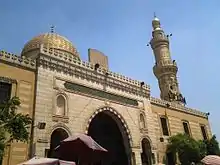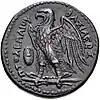| Al-Sayyida Nafisa Mosque مسجد السيدة نفيسة | |
|---|---|
 | |
| Religion | |
| Affiliation | Islam |
| Region | Middle East |
| Status | Active |
| Location | |
| Location | Cairo, Egypt |
| Architecture | |
| Type | mosque |
| Style | Islamic |
| Specifications | |
| Dome(s) | 1 |
| Minaret(s) | 1 |
The al-Sayyida Nafisa Mosque is a mosque in al-Sayyida Nafisa district (or Sebaa Valley), a section of the larger historic necropolis called al-Qarafa (or City of the Dead) in Cairo, Egypt. It is built to commemorate Sayyida Nafisa, an Islamic saint and member of the family of the Islamic prophet Muhammad. The mosque contains her mausoleum, also known as a mashhad. She was the great-granddaughter of Hasan, one of the Prophet Muhammad's two grandsons.[1] Along with the necropolis around it, the mosque is listed as part of the UNESCO World Heritage Site of Historic Cairo.[2]
Sayyida Nafisa
Sayyida Nafisa is considered holy as a member of the Prophet’s family and her piety earned her the special status of an Islamic saint.[3] She emigrated from Hejaz to Egypt and eventually settled in Fustat where she had a reputation for performing miracles.[1] Before her death in 824, she made the hajj, or pilgrimage to Mecca, thirty times.[4] She was renowned as a huffaza, meaning she knew the Qur'an by heart.[4] Before she died, she reportedly dug her own grave and sat in it while she recited the whole of the Qur’an 190 times, saying "Rahma" ("mercy") with her last gasp.[4] After her death, the people of al-Fustat begged her husband not to take her body back to Medina, but rather to bury it in al-Fustat because of her baraka, or her blessing and grace from God.[5]
History of the mosque
Al-Maqrizi's plans indicate that the first person who built the tomb of Nafisa was Obaidullah ibn al-Suri, governor of Egypt during the Abbasid era. Cerca 1089, Badr al-Jamali began renovations by restoring a gate entrance to the mosque,[5] Badr also restored the Mashhad of Sayyida Nafisa with an inscription that designated his son as co-initiators in the restoration, however, the present Mashhad was built much later on in the Ottoman period.[5] Badr restored the shrine of Sayyida Nafisa in 1098 — of the fifty two extant foundation inscriptions of the Fatimid period, twenty bear the name of Badr who was the Armenian governor of ‘Akka (he was also a wazir and commander in chief of the Fatimid army) and was summoned to Cairo by the Fatimid caliph al-Mustansir in 1074 after a famine.[6] Badr was the first ruler of the Fatimid state to set up a public vault for ‘Alid saints, and Sayyida Nafisa was the first ‘Alid officially honored by Badr al-Jamali, supposedly because she could represent conciliation at a popular level of both the Shii rulers and the Sunni population within the Fatimids.[5]
There were later renovations by the Fatimids and the Abbasids in 1171.[7] During this time, many tombs and shrines were built or restored because two succession crises and two periods of assassination had undermined the Fatimid government’s spiritual and political authority.[5] Then the shrine was reconstructed during the Fatimid era, which a dome was also added. There is however, no history available regarding the architecture on a marble tablet placed on the door of the shrine which shows the name of the Fatimid caliph Mustansir and his titles.
In 1138, Caliph al Hafiz renewed the dome over the grave and ordered a marble lining for the mihrab.[5] Surviving woodwork from the Mashhad includes the top half of a wooden screen filling in the shape on an arch. The arch is made up of panels of inscription with naskh characters, which did not appear on monuments in Egypt until the Ayyubid period, indicating that there were renovations in the 12th and 13th centuries. Also on the arch, there is an inscription in Kufic lettering, easily read as 33:33 of the Quran, stating, “O People of the House, God only desires to put away from your abomination and with cleansing to cleanse you.”[5]
The mausoleum was renewed in the Ottoman era during the reign of Prince Abd al-Rahman Katkhuda, which he built the shrine on the form existing until today. There are entrances for male and female, and the entrances were renovated in the modern era with marbles and extravagant carpets. Inside the mosque, there exists a corridor which leads to the Sharif's room, and paintings and poems of praise concerning the Ahl al-Bayt are drawn and written over the corridor.
The present mosque dates to 1897, ordered by ‘Abbas II when the mosque rebuilt by ‘Abd al-Rahman Katkhuda in the eighteenth century was damaged by fire,[5] However, in the late 1980s, a whole new extension wing was attached to the mosque in order to serve as a center for Quranic and religious instruction.[5]
A new zarih over the tomb was inaugurated during the visit of the leader of the Dawoodi Bohras in June 2021.
In the late summer of 2023, the Mosque underwent a controversial renovation sponsored by the Indian Bohra community. The interior had previously held a Mamluk aesthetic but that has been covered with Asian styled marble.[8] Much of the interior woodwork was moved to the mausoleum of Ibn Ataa Al-Sakandary during the renovation.[9] Prince Abdel-Rahman Katkhoda created two different doors for men and women. Additionally he wrote in gold, “The throne of truth and secrets, the tomb of Nafisa, daughter of the source of all lights. Hussein, son of Zaid, son of Hussein, son of Imam Ali, the cousin of the Prophet, the chosen one.”[9]
Location
Sayyida Nafisa Mosque is located at the border between al-Qata'i from al-Askar. The location of Sayyida Nafisa’s tomb is believed to have been the location of her house.[5] It is set on al-Khalifa street, where numerous mausoleums commemorating well known Islamic figures exist along the way.[1] After she died, many people were buried near her to benefit from her baraka, or blessing.[5] In addition to the mosque and mausoleum of Sayyida Nafisa, the street is also the location of the mausoleums of Sayyida Sakinah bint Husayn, Sayyida Ruqayya bint Ali, Sayyid Muhammad ibn Jafar al-Sadiq, and Sayyida 'Atikah, believed to be an aunt of Muhammad.[1] This necropolis was originally built in the period of the Fatimids, when many commemorative mosques and Mashhads were constructed to honor religious subjects that were holy to the entire community, rather than a singular person. Most of these tombs and shrines were sacred to the memory of the Prophet’s family, including Sayyida Nafisa.[5]
See also
References
- 1 2 3 4 Williams, Caroline (2008-06-01). Islamic Monuments in Cairo: The Practical Guide; New Revised Edition. The American University in Cairo Press. doi:10.2307/j.ctv2k93tcq. ISBN 978-1-61797-626-1. JSTOR j.ctv2k93tcq. S2CID 248850625.
- ↑ Navickiene, Egle (2007-09-03). "New Buildings in the Vilnius Historical Centre, a UNESCO World Heritage Site". Urban Heritage: Research, Interpretation, Education. Vilnius, Lithuania: Vilnius Gediminas Technical University Publishing House Technika: 83–89. doi:10.3846/uh20070925.83-89. ISBN 978-9955-28-177-1.
- ↑ Grant, Beata (May 2001). "Women Saints in World Religions. Edited by Arvind Sharma. Albany: State University of New York Press, 2000. xi, 244 pp. $19.95". The Journal of Asian Studies. 60 (2): 510–512. doi:10.2307/2659712. ISSN 0021-9118. JSTOR 2659712. S2CID 143665392.
- 1 2 3 Bloom, Jonathan M. (1987). "The Mosque of the Qarafa in Cairo". Muqarnas. 4: 7–20. doi:10.2307/1523093. JSTOR 1523093.
- 1 2 3 4 5 6 7 8 9 10 11 12 Williams, Caroline (1985). "THE CULT OF ʿALID SAINTS IN THE FATIMID MONUMENTS OF CAIRO PART II: THE MAUSOLEA". Muqarnas Online. 3 (1): 39–60. doi:10.1163/22118993-90000195. ISSN 0732-2992.
- ↑ Behrens-Abouseif, Doris (February 1995). "Tarek Mohamed Refaat Sakr, Early Twentieth-Century Islamic Architecture in Cairo (Cairo: The American University in Cairo Press, 1992). Pp.97". International Journal of Middle East Studies. 27 (1): 129–130. doi:10.1017/s0020743800061791. ISSN 0020-7438. S2CID 161339719.
- ↑ AL-MUSA, C.A.B.F.M., HASSAN M. (2019-12-01). "Prolonged Daily Screen-Time among Saudi Secondary School Students". The Medical Journal of Cairo University. 87 (12): 4221–4226. doi:10.21608/mjcu.2019.77410. ISSN 2536-9806. S2CID 214706391.
- ↑ Mohammed Ibrahim Ali, Nourhan (2018-08-01). "Evaluation of Visual Performance of Religious Urban Open Spaces (Case study: Al- Sayyida Nafisa Mosque Square in Cairo, Egypt) تقییم األداء البصرى للفراغات العمرانیة ذات الطابع الدینى )دراسة حالة فراغ مسجد السیدة نفسیة بالقاهرة - مصر(". Journal of Engineering Research. 2 (8): 131–137. doi:10.21608/erjeng.2018.125136. ISSN 2735-4873. S2CID 240330430.
- 1 2 nafisa, safira audrey (2023-01-26). "Ai". dx.doi.org. doi:10.31219/osf.io/h736a. Retrieved 2023-12-08.


